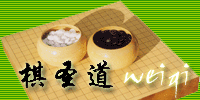|
|
|
|
|
|
|
|
 |
Igo and Weiqi from Ancient to Modern writing |
|
2003-10-28,29 ,30Background for this articleInitially, I try to answer Scott Thompson newsgroup question on the meaning of Japan Kanji "igo" and what is the different between "igo" and just "Go". As you know on both both Chinese and Japanese, you will know the i-go "i" is the meaning of "surround"; which is like "wei-qi" - "wei" standard for the "surround". Japanese "go" is Chinese "qi" writing, in Japanese kanji writing (if you know the history of Japan adopted Chinese into their culture before^_^;). Actually the keyword for both Chinese and Japanese should be the "surround" , not the word "qi" or "go" which can translate as the "meaning of game". More proper way for searching the ancient text should use the world in "weiqi" or "igo" - in kanji form. As I intend to express my idea to illustrate how ancient way of the writing for Western igo-weiqi fan to have a really clear idea on how the words for both Chinese and Japanese character change along the time. And I strongly believe the most easy way of learning Chinese or Japanese Kanji (Japanese's Chinese Character) is by "knowing" the character meaning, then how to pronounce, since they most important is "communicate meaning" across. Even have some kindly people propose to using Unicode text and X-face
method, I still find it can not reserve the ancient writing for people
objectively "learn" the difference visually. Since I thinking of using
ancient writing to stress my point, and use the both ancient and modern
character writing to "speak" for itself (because Unicode lack of ancient
fonts, and it is no make sense for people not frequent using those fonts to
installed them just to enable them to see some text). So, I create the key
message in graphic form (and let it speak for itself with some descriptive
text), and I initially post it in my personal blog. And then transfer to
here for more permanent host for people who want to make a links (as Hans-Georg
Michna
propose). I make a mistake on the first Ancient Qi character, and using the
wrong font for it, and I like to thank you TactiGo who pinpoint my mistake,
and provide the right character for it. So what you currently see should be
correct ^_^; Ancient to modern writing of weiqi and igoBasically Ancient writing of "Qi" is associate with "stone" element, because in ancient time, weiqi play in stone board (or stone rock), and modern writing of "Qi" is associate with the "wood" elements, because modern weiqi is play on the "wood board". I hope it help to answer the question clear.
|
||
(c) 2003 Lim Kim Keong. All Right Reserved.